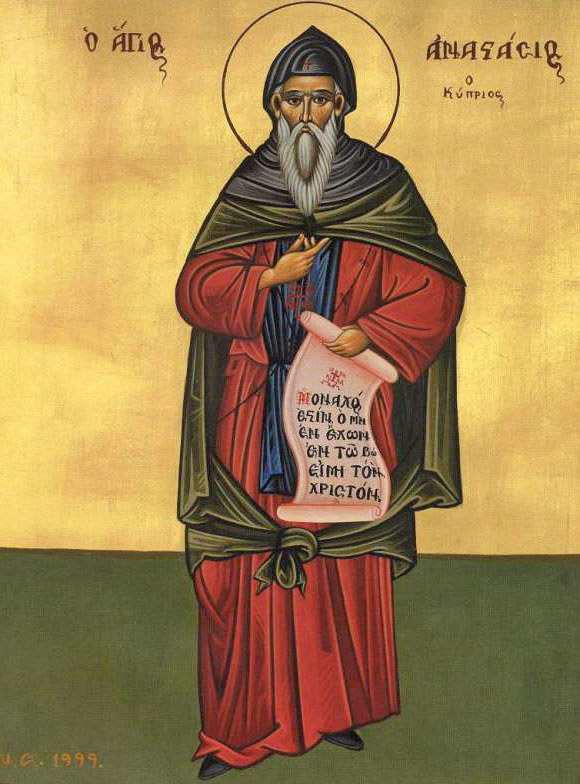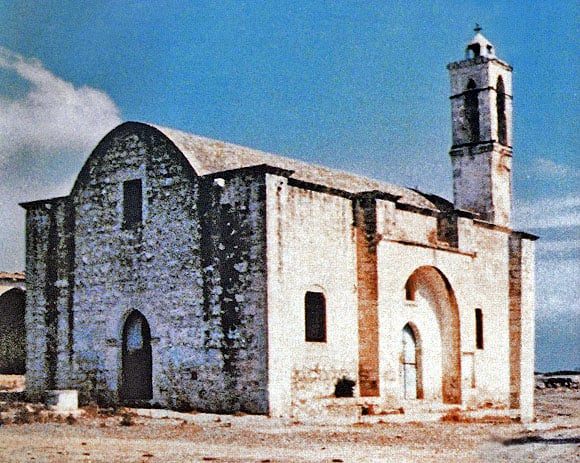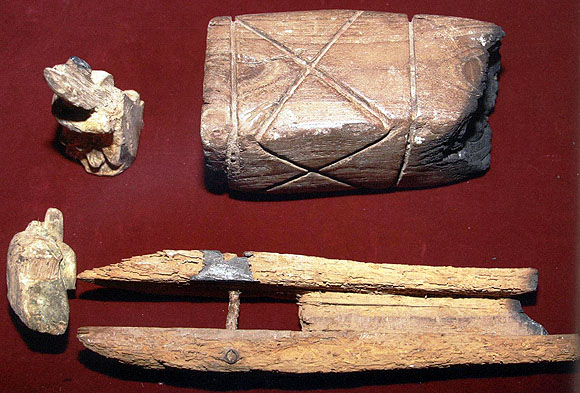Saint Anastasios the Weaver from Peristerona, Cyprus
18 September 2013Leontios Makhairas, the 15th century chronicler, reports that Saint Anastasios was one of the 300 clergymen and lay people who fled to Cyprus from Jerusalem, in 638, in order to escape the wrath of the Arabs who had just conquered the city.
“When the Saracens took the promised land, then the poor Christians came out from their hiding-places and went wherever they found refuge. There were archbishops, bishops, priests and lay people and they went wherever they could reach. And one group came to famous Cyprus. They were about 300 in number and, hearing that Greeks were in charge there, they went, from fear, from one place to another, digging the ground and going in there and praying to God”…
Saint Anastasios the Wonder-worker found himself in Peristerona; Saint Konstantinos in Ormetian; and Saint Therapon a soldier in Sindan”…

Even though Saint Anastasios’ life is not well-known we have some details from a synaxarium [martyrology, hagiography] in an old service to him. This tells us that he was one of 300 Orthodox from Alamannia (Germany), who took part in a crusade at the time of Emperor Alexios Komninos (1081-1118) and his son, Ioannis (1118-1143). Later, when they were expelled by the Latins in Palestine, they found refuge in Cyprus, where they lead a monastic and ascetic life.
“This man, our Blessed Father Anastasios, was in the time of the Emperor of the Christians, Alexios Komninos and his son Ioannis. Together with 300 other Orthodox from Alammania, he lived the monastic life in Cyprus, which was then subject to the Orthodox Emperor. When the so-called Holy War was declared and was undertaken supposedly for the holy pilgrimage sites, these soldiers also came with the others. Seeing that the Orthodox were abused in wars by the Latins, who were commanders of the earthly army, they enlisted with the Heavenly King. The took the arms of the monastic state in Cyprus, where, living in deserts and mountains, dispirited, mortified and under attack from demons, they defeated every temptation by the power of Christ, Who strengthened them. Through their great virtues they also were able to work many miracles, not only while they lived but also after death. Thus, to this day, those who approach the grave of Saint Anastasios with reverence find him to be an excellent physician, who is swift to help those who invoke his aid. By his prayers, Christ our God, have mercy upon us, Lover of Mankind”.
We should note at this point that this information concerning Saint Anastasios and three other saints who are mentioned as being from the Alamanns or Alamannia (Kendea, Therapon and Avxentios) is much later and can be dated to the 18th or early 19th centuries. We should therefore treat it with circumspection.

In looking at the information regarding Saint Anastasios, we should take seriously into account a recent study by the historian and researcher Kostas Kyrris, who, basing his views on Coislin Codex 105 from the 10th-11th centuries, places the saint before the 10th century, that is quite a long time before the period mentioned in the brief synaxarium. Kryrris writes that the fact that Anastasios lived before the 10th century is confirmed by the existence of his life in the Coislin Codex, since this can be dated to the 10th-11th centuries.

The old Church of Saint Anastasios, Peristeropigi
We should also quote, even in brief, the conclusions of a recent study by Monk Hariton Stavrovouniotis on the thorny question of the saints who came [to Cyprus] from abroad, among whom is Saint Anastasios.
a) All of them were genuine Roman monks (that is they were Orthodox in faith and came from various regions of the unified Roman-Byzantine Empire.
b) They did not all come to Cyprus at the same time, but at different periods (though certainly Early or Middle Byzantine) and under a variety of circumstances (…).
c) The precise number of these saints is not known exactly, although the tradition recorded in the chronicles raises it to the number 300, which was symbolic in sacred texts as meaning a large number.
Although much has been written by numerous scholars regarding the time, the appellation “Alamanns” and the conditions under which the 300 Alamann saints arrived in Cyprus, we shall not mention anything more here. We shall focus more on the saint’s miracles and on the evidence of his presence. This evidence is his tomb and the weaving tools which he used while he was living in a cave in Peristerona, in Mesaoria. Saint Anastasios the Wonder-Worker, as he is known, lived a life of fasting, vigils and prayer, curing all illnesses. His aid was sought particularly by those suffering from rheumatism, arthritis, paralysis and fractures.

The utensils of Saint Anastasios the Weaver
Saint Anastasios never stopped working in order to earn his daily bread. In a hewn-out cave, which he chose for his ascetic life, he set up his loom and wove sacks in which cereals could be kept or transported. On his grave, on a little ledge, the wooden shuttles he used were kept, in very good condition, until August 1974. People wanting his help would rub themselves with them in order to be cured. Later they were placed before his icons in the two neighbouring churches, the old monastery one and the new one. Pilgrims would also bring wax figurines on his account.
The memory of Saint Anastasios is celebrated on 17th of September.
Source: Βίος-Θαύματα-Ακολουθία του Οσίου και Θεοφόρου Πατρός ημών Αναστασίου του Θαυματουργού του εν Περιστερωνοπηγή, published by The Holy Monastery of Vatopaidi, pp. 11-16.






